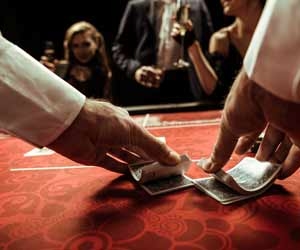Craps Dealers
Four people work on a craps staff. The boxperson remains seated while supervising the play and guarding the table bankroll.

He watches the action at the table, settles player/dealer disputes, and examines any dice thrown off the table for imperfections. At very busy tables there may be two boxpersons. The stickperson stands opposite the boxperson, overseeing the center region of the layout, pushing the dice back to the shooter after each roll with a flexible stick. This person also announces each roll of the dice, enhancing the atmosphere at the table with small talk and such pronouncements as, “Seven! Winner on the pass line,” or “Hot roll coming up, better get those field bets down.” The more continuous the patter, the more lively the table. The two standing dealers are the liaisons to the players and stand at either end of the table. The dealers convert players’ cash into chips, move the “buck” (a small plastic disk) to a corner number box to indicate the point, handle all place bets, move come and don’t come bets to the place number boxes, collect losing wagers, and pay off winners.
Those interested in working at the craps table would first learn all the positions through specialized training. Craps dealers need good communication skills, manual dexterity, and the ability to think and act quickly, as this is usually a high-energy game. Math skills, also, are a must. Casinos rotate their craps dealers so each gets a turn at a different function and will stay sharp. Dealers are allowed to remind players to pick up their winnings before the next roll or may even advise them on good bets. Dealers earn an hourly wage, usually around minimum wage or a buck or two higher, with tips making up a large portion of their income. Since players at a craps table are usually extroverted and friendly due to the physical nature of the game, they tip frequently.


 Teach English in Asia
Teach English in Asia  Cruise Ship Jobs
Cruise Ship Jobs  Alaska Fishing Industry Jobs
Alaska Fishing Industry Jobs  Sharing Economy / Gig Economy
Sharing Economy / Gig Economy